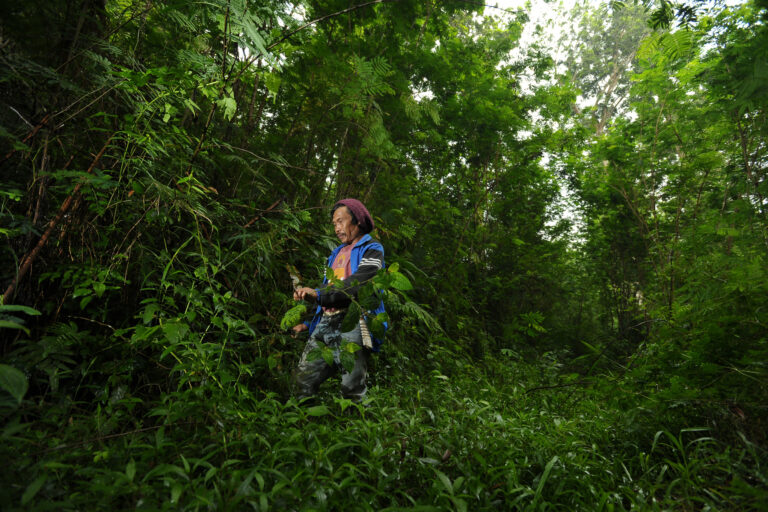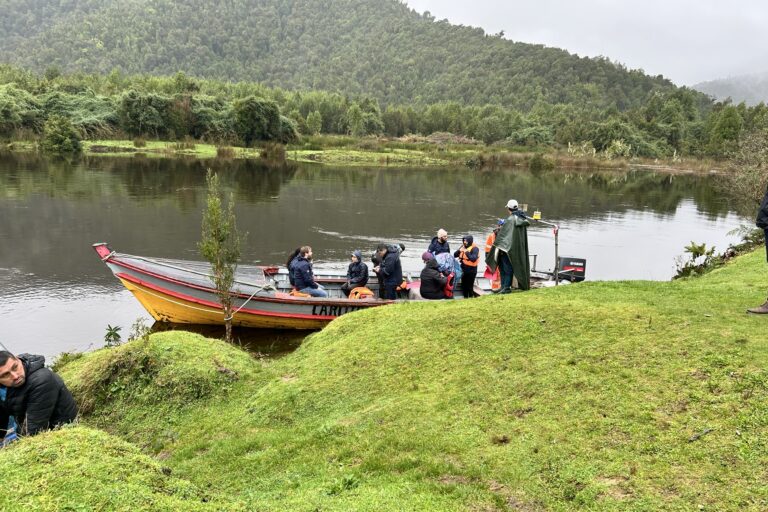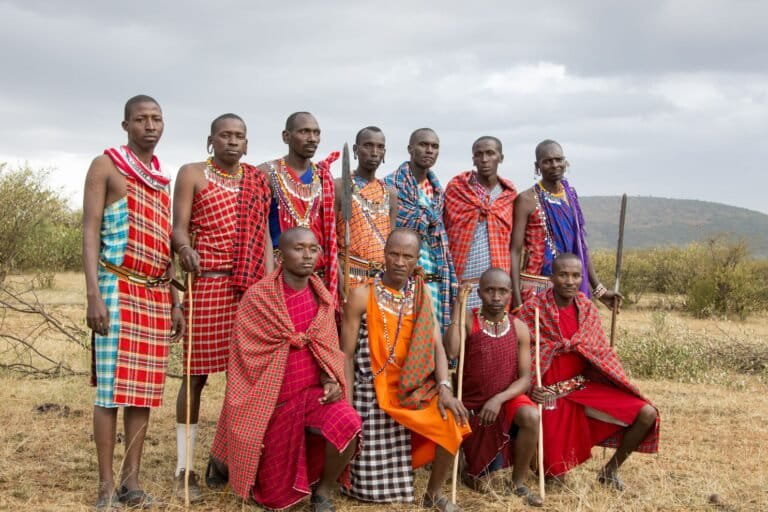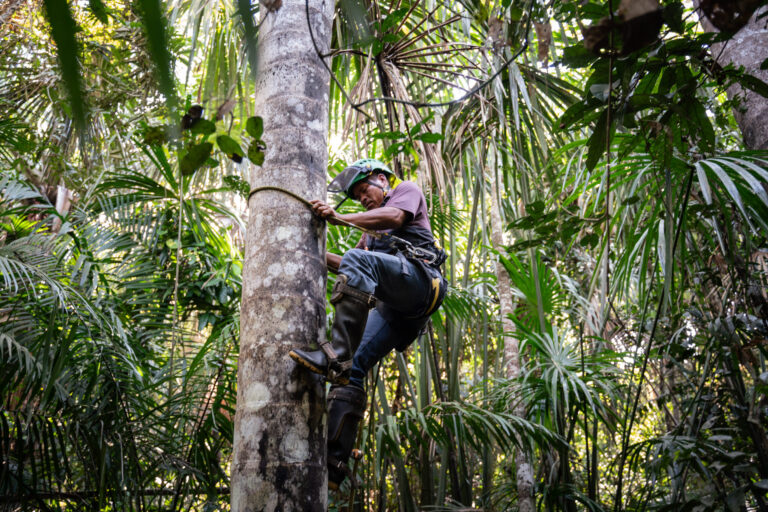- Discovered in 2010 and promptly listed as Critically Endangered, the Myanmar snub-nosed monkey lives only in the remote high forests of Northeast Myanmar, and across the border in China’s Gaoligong Mountain Natural Reserve. There are as few as 260-330 left in the wild.
- Hunting, illegal logging and proposed hydropower development, taking place within the context of a simmering civil conflict, threaten to push the species to extinction.
- On the plus side, conservationists have already gone a long way toward winning over local communities, getting them to stop hunting the animals; while the government’s approval of a newly proposed national park offers hope that the Myanmar snub-nosed monkey can be preserved.

Back in 2010, scientists discovered a new primate species with a distinct and unusual aversion to rain. Tipped off by hunters’ stories, they found the Myanmar snub-nosed monkey (Rhinopithecus strykeri) in the country’s remote northeastern state of Kachin, near the border with China.
A small flood of scholarly and popular articles followed, highlighting the quirkiness of the new primate that locals say covers its face whenever there is a downpour, lest it sneeze as the water trickles into its upturned nose and reveal its position.
But what happens to a new species once discovered, after the media spotlight moves on — particularly when that species is immediately listed as Critically Endangered by the IUCN?
Rain, a monkey’s bane and maybe, a friend?
Though known to locals, the Myanmar snub-nosed monkey’s story begins for conservationists, primate scientists and the outside world a mere six years ago. R. strykeri was found as the inadvertent result of a survey on Hoolick gibbons. Hunters interviewed told of a bizarre species that sneezed during the rainy season, a tell tale sound that guides their guns to the quarry.
The research team was intrigued: it seemed likely this was a species previously unknown to science, and indeed it was.
The researchers were guided to a skull and skin of the unknown monkey in a hunter’s lodge (the skin had been made into a pouch). Soon after, they were presented with a carcass. That was enough to confirm their suspicions and hopes. The discovery made headlines — as it’s not every day a new primate is uncovered in today’s world.

Unfortunately for R. strykeri, the footprint of human encroachment had already trod heavily upon the species. Isolated in a remote and mountainous part of Myanmar, this new type of Snub-nosed monkey had no sooner been “discovered” than it was listed as Critically Endangered: the researchers estimated that only around 260-330 individuals remained in the wild.
Loss of habitat (largely due to mechanized, often illegal logging) and hunting had presumably diminished the population significantly. As part of the genus Rhinopithecus, the Myanmar species joined the other Snub-nosed monkeys, the Tonkin, Golden, Grey and Black, on the IUCN’s list of endangered species. These five species, distributed between China and the northern reaches of Myanmar and Vietnam, number around 30,000 in the wild.
The newly identified species again made headlines in 2012. Scientists working in China discovered a sub-population in the Gaoligong Mountain Natural Reserve, near the Myanmar border. The population there numbered less than one hundred.
Two years later came another first; footage of the species was released showing a troop of monkeys leaping through forest canopy.
Mongabay recently caught up with the researchers studying the “sneezing monkey” to find out what has been happening since its scientific discovery made the headlines, and to see how the species is fairing in the wild.
Between a dam and a hard place
Bluntly put, the Myanmar snub-nosed monkey’s narrow boundaries of evolutionary development stand between it and its hopes for survival. It’s remaining high altitude cool temperate rain forest and mixed temperate forest habitat is sandwiched between two large rivers, the Irrawaddy and the Salween, so the species’ home is surrounded by prime hydropower potential. And with dam construction there almost always comes ancillary development, deforestation and human access to once wild places.
There is some good news for R. strykeri. The proposed Myitsone dam project, which consists of seven dams spanning the headwaters of the Irrawaddy River and several other tributaries, in Myanmar has been on hold since September 2011. Despite assurances from the China Power Investment Corporation, the firm leading the venture, the project has proven extremely controversial. The main dam on the Irrawaddy River would, say critics, cause major flooding of the forest environment and agricultural land. While this would not directly impact the Myanmar snub-nosed monkey’s high altitude conifer habitat (known to include silver fir forest that occurs at elevations of 2,745-3,660 meters; 9,000-12,000 feet), the construction of dam access roads would likely expose the monkey’s habitat to more deforestation and hunting pressures.
As reported in The Irrawaddy, a proposed series of dams on the Ngaw Chan Kha (a tributary of the N’Mai Hka River) would flood the houses and farms of some 30,000 people. Momberg worries that the loss of traditional terrace farming there may drive local people farther into the hills to make a living, encroaching on the Myanmar Snub-nosed monkey’s range. “If people lose their rice terraces, they will have no alternative than to return to shifting cultivation,” he said.
Similarly, mechanized logging for precious woods — a problem which has long plagued Myanmar —has come to the region. Between 1990 and 2015, the country lost an estimated 15 million hectares (approximately 58,000 square miles) of forest cover, placing it behind only Brazil and Indonesia in terms of its rate of deforestation in 2010. In 2014, the country enacted a ban on exports of timber to curb the cutting, a prohibition that was reinforced early this year. While the situation has improved somewhat in Myanmar, the country’s Environmental Investigative Agency reported last year that an illicit logging trade still thrives just across the Chinese border.
Logging and hunting pressures
Unfortunately for endangered species like the snub-nosed monkey, hydropower, logging and hunting all go hand in hand to synergistically worsen threats. The building of dams requires the opening up of formerly remote forests to roads and transmission lines. Loggers use those dam access routes to transport logs, while also penetrating even more remote areas with rough haul roads. And all those new roads make it easy to get to places that were previously inaccessible to all but the most avid hunters.

And unfortunately for R. strykeri, it is quite easy to hunt. Its peculiar sneezing habit during rain storms makes it an audible target. Scientists’ interviews with hunters revealed that at least 13 Myanmar snub-nosed monkeys were hunted and killed during 2009, according to the IUCN. If this figure is extrapolated over three-generation spans (each lasting at least 18 years), the rate of loss would be 234 monkeys, or 90 percent of the conservatively estimated current total population of 260 individuals.
The good news: local community awareness and a new conservation ethos, born out of the educational efforts of Flora and Fauna International (FFI), has reduced the direct targeting of the Snub-nosed monkey since its scientific discovery.
Yet the animal is still accidentally falling victim to hunters. Ngwe Lwin, a conservationist and part of the team that discovered the species, explained that hunters who live off the forest often set traps meant for bears or other large mammals (bear gall bladders and skins can fetch high prices in Chinese markets).
“Basically the [Snub-nosed monkey] is not the target for hunters because there is not a big market for them in the border area. Normally they cannot sell them.” He said. There are reports of the monkeys’ parts, such as the skull, skin and bones, appearing on Chinese wildlife markets, presumably to be used in traditional medicine. It is said that a bag of Myanmar monkey bones fetches around US $30 in China. The IUCN reports that Snub-nosed monkey parts are sometimes sold to Chinese workers at road construction and logging camps, and to wildlife traders in Kangfang, the nearest town to the animal’s territory on the Chinese border.

Even as R. strykeri’s popularity as a target species declines, hunting has stayed high on the list of risks to its survival. “One of the main threats is iron [cage] trapping [for bears and other animals], and when the hunters go into the forest and they see the monkey, they shoot it,” Lwin said. In such cases, easy access to the forest and the opportunity to snag either a quick meal or a few dollars is hard to pass up.
Hope for the sneezing monkey
According to Lwin, local hunters can easily identify different species of animal in the forest such as the Snub-nosed monkey or the Red panda. However, the problem in the past has been that they didn’t know that there were so few of the endangered animals left. “That’s why we first give them information… and later we facilitate at the village level to form village conservation groups,” he said.
To date, 28 village conservation groups have been established in the area surrounding the Myanmar snub-nosed monkeys’ habitat, according to Lwin. Once informed of the rarity of the species, many hunters have agreed to stop setting up iron traps within its range and to stop shooting it.
“The current situation is quite good,” Momberg said. Despite the multiple threats facing the monkey, it is now benefitting from a perfect storm of bans: “Hydropower is on hold; illegal logging is on hold. That means the species could have a positive future for survival.”
Momberg also reported that the recent clampdown on logging is working. He revealed that no illegal logging has occurred within the area inhabited by the monkey since the beginning of this year. In a stroke of good fortune for the Snub-nosed monkey, strong seasonal rains also washed away some logging roads, limiting access to the forest and thus closing a potential door to wildlife traffickers.

Despite this, he remains cautious: “The future of the monkey is not secure,” Momberg warned. “The moratorium on the development of the hydropower project lapses this year, and whether or not the project will be renewed or scrapped is unclear. “
For Momberg the answer to this single “big question mark” is crucial.
If the project goes ahead, the Myanmar snub-nosed monkey may well be plunged back into peril and toward oblivion. Unlimited road access into the forest, without restrictions or checks for hunters, could result in a massive increase in wildlife trafficking, he said. The prospect concerns him deeply, as free entry into the deep forest “could easily lead to the extinction of the species.”
Alongside these more “traditional” conservation threats, Momberg outlines another: political instability in Kachin state threatens the survival of the Myanmar snub-nosed monkey too.
Conservation is often an unseen victim during major periods of civil unrest. When bullets fly, the continuation of research projects can become impossible; roaming bands of soldiers can kill animals for food or for the wildlife trade, and starved rural communities may be forced to eat wildlife they would normally protect. For example, a two-decade civil war that devastated the Democratic Republic of the Congo also devastated its population of Grauer’s gorillas (Gorilla beringei graueri).
Long-running battles between the federal government of Myanmar and the Kachin Independence Army (KIA) did not reach into the Myanmar snub-nosed monkeys’ habitat in past years, but the conflict did stretch as far as the region’s access roads.
This had consequences for primate researchers; FFI’s operations were halted intermittently for a period of about two years between 2014 and 2015, Momberg said. International scientists found it difficult and dangerous during that time to gain access to the area. “Our project never really stopped. But for international staff we had part-time restrictions,” he revealed.
For now, a tenuous ceasefire is in place and holding, but there’s no certainty that peace is secure or that the conflict might reignite.
Conserve the forest, conserve the monkey
A key to preserving any species is, of course, protecting its remaining habitat. In an important step toward that goal for the Myanmar snub-nosed monkey, a new national park is currently being designed, known as Imawbum National Park. This preserve will encompass the species’ territory and give it much needed permanent protection from loggers and hunters.
“One of the reasons why nobody seemed to take action against logging in the past was because this was unclassified forest,” Momberg explained, and so it did not fall under the control of the state forest department. For some time, forest access was not even under government control, but rather that of a Kachin separatist group. In a sense, said the researcher, governance of the area in which the monkeys lived was a political free-for-all.

But today the park is moving forward. Consultations with local communities have been highly positive, with almost all agreeing to the creation of the new park. Next, the preserve boundaries need to be laid out, and then the final administrative steps taken.
According to Momberg, the Imawbum Park will be Myanmar’s first, where free and prior consent is enshrined. With major administrative and bureaucratic hurdles still to be overcome, it may yet be a couple years before the park is officially announced. Nonetheless, it’s a major step forward toward preservation for the Myanmar snub-nosed monkey, as well as other species inhabiting the region such as the endangered Red Panda (Ailurus fulgens) and the rare Takin (Budorcas taxicolor), which is a kind of goat-antelope hybrid.
Working with local communities and achieving their cooperation will be key to the success of the park, said Momberg. “We’ve had the first successful steps. We want to achieve in the long-term a fully staffed and managed park… a collaborative system working with local communities.”
A less than beautiful species
It’s safe to say that the conservation attention heaped on the Myanmar snub-nosed monkey since 2010 was most definitely not based on the species appearance. In fact, the animal, as seen in its very few blurred, distant photos, could be described as decidedly un-pretty. Covered in mostly black fur with tufty white ears; with a pinkish face, white beard and up-turned nose (the cause of the chronic rain-induced sneezing); this particular Snub-nosed monkey isn’t a looker.

When asked why it should be conserved Momberg agrees to the unlikelihood of the animal winning any beauty pageants: “I mean of course it might not be the most beautiful species, but it’s certainly unique!”
Unique, and so far, little understood. Scientists don’t know much more about the monkey than they did six years ago, and are only in the early stages of study. Wary of humans due to years of hunting, the monkeys are rarely encountered, making data gathering difficult. Momberg describes them as “shy”. Lwin still hasn’t seen the monkey alive in the wild, though members of his field team have.
This elusiveness makes counting the animals possibly fluctuating numbers challenging. Lwin believes the population is “more or less stable”, but with the animals dwelling for long stretches of the year in steep, high altitude habitat that is often covered in deep snow, the researchers don’t really know if that assessment is accurate.
“So we haven’t been very successful in counting the monkey,” Lwin conceded.
But what scientists have learned is striking. Research has begun to divulge a picture of a highly social primate. From the, admittedly, scant observations, the species appears to have a unique social organization, unlike any other primate species observed in Myanmar or Southeast Asia.
“Langurs live in a maximum of twenty to thirty [in a] group,” Momberg explained, while the Myanmar snub-nosed monkey seems to live in much larger bands, of up to 100 individuals. “None of the other species have these large bands in Southeast Asia.”
Researchers believe that there are three to four existing populations of the new species, occurring within their range around Myanmar’s Maw River. One group, north of the Maw, contains 60-80 individuals; a second group, south of the river has 80-100; and a group of about 150 lives in the foothills of major mountains above Chichitago village, according to the IUCN.
Momberg justifies the need to protect this endangered monkey: “It is [not only] very unique, [but also] a charismatic flagship species for this area,” he said.
Though news since the 2010 scientific discovery is promising — with a major dam on hold, illegal logging banned, local communities supporting conservation efforts, and a national park in the works — the future of the species remains in a fragile state.
The next chapter in the story? Getting to know the sneezing monkey a little better, building a knowledge base that can help in its conservation.

On the ground, Lwin and his team are hoping to begin filling some of those knowledge gaps very soon. Later this year they plan on working with biologists to study the local populations; learning about their behavior, movement and more.
In the long term, survival for the Myanmar snub-nosed monkey depends on finding solutions to all too human problems.
Will the region’s fragile peace hold? Will plans for the Myitsone dam project be permanently shelved? And how can China’s insatiable demand for wood, energy and wildlife be met, without putting R. strykeri back on to the road to extinction?
A more urgent question may be whether or not the separate tributary dam project on the Ngaw Chan Khka goes ahead, despite strong local opposition. The dam could have direct consequences for the Imawbum National Park and thus for the species, as reservoir flooding drives agriculture into the high hills encroaching on critical habitat. Competition for land from local people, deforestation and the possibility of yet more roads and trails carved into remote forest would add a raft of potential perils to those already endured by the threatened primate.
Strangely and ironically, it could be that the Myanmar snub-nosed monkey may have been saved for posterity by that tell tale sneeze. This odd trait, related by hunters to scientists, brought this Almost Famous primate into the public eye, and into conservationists’ consciousness.
Now, hunters wanting to shoot these animals are being steadily replaced by biologists wanting to study them. Thus hope remains that in the not too distant future, when a sneeze is heard on a rainy day in the high altitude forests of Northeast Myanmar, the only shooting going on may be through a camera lens.














